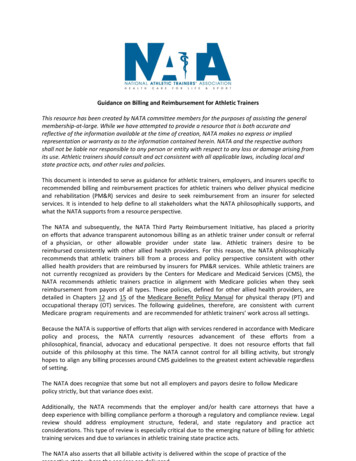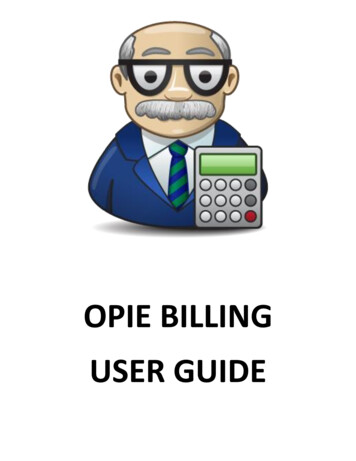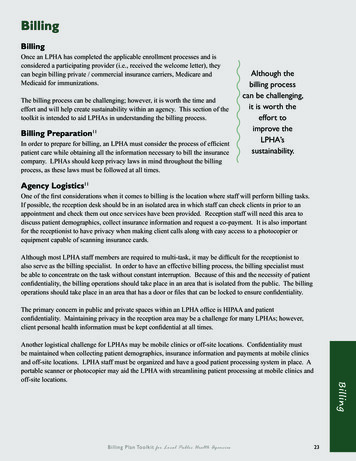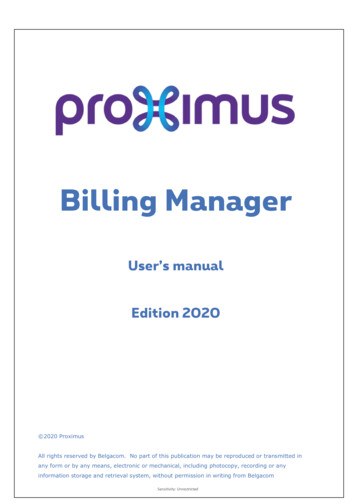
Transcription
Guidance on Billing and Reimbursement for Athletic TrainersThis resource has been created by NATA committee members for the purposes of assisting the generalmembership-at-large. While we have attempted to provide a resource that is both accurate andreflective of the information available at the time of creation, NATA makes no express or impliedrepresentation or warranty as to the information contained herein. NATA and the respective authorsshall not be liable nor responsible to any person or entity with respect to any loss or damage arising fromits use. Athletic trainers should consult and act consistent with all applicable laws, including local andstate practice acts, and other rules and policies.This document is intended to serve as guidance for athletic trainers, employers, and insurers specific torecommended billing and reimbursement practices for athletic trainers who deliver physical medicineand rehabilitation (PM&R) services and desire to seek reimbursement from an insurer for selectedservices. It is intended to help define to all stakeholders what the NATA philosophically supports, andwhat the NATA supports from a resource perspective.The NATA and subsequently, the NATA Third Party Reimbursement Initiative, has placed a priorityon efforts that advance transparent autonomous billing as an athletic trainer under consult or referralof a physician, or other allowable provider under state law. Athletic trainers desire to bereimbursed consistently with other allied health providers. For this reason, the NATA philosophicallyrecommends that athletic trainers bill from a process and policy perspective consistent with otherallied health providers that are reimbursed by insurers for PM&R services. While athletic trainers arenot currently recognized as providers by the Centers for Medicare and Medicaid Services (CMS), theNATA recommends athletic trainers practice in alignment with Medicare policies when they seekreimbursement from payors of all types. These policies, defined for other allied health providers, aredetailed in Chapters 12 and 15 of the Medicare Benefit Policy Manual for physical therapy (PT) andoccupational therapy (OT) services. The following guidelines, therefore, are consistent with currentMedicare program requirements and are recommended for athletic trainers’ work across all settings.Because the NATA is supportive of efforts that align with services rendered in accordance with Medicarepolicy and process, the NATA currently resources advancement of these efforts from aphilosophical, financial, advocacy and educational perspective. It does not resource efforts that falloutside of this philosophy at this time. The NATA cannot control for all billing activity, but stronglyhopes to align any billing processes around CMS guidelines to the greatest extent achievable regardlessof setting.The NATA does recognize that some but not all employers and payors desire to follow Medicarepolicy strictly, but that variance does exist.Additionally, the NATA recommends that the employer and/or health care attorneys that have adeep experience with billing compliance perform a thorough a regulatory and compliance review. Legalreview should address employment structure, federal, and state regulatory and practice actconsiderations. This type of review is especially critical due to the emerging nature of billing for athletictraining services and due to variances in athletic training state practice acts.The NATA also asserts that all billable activity is delivered within the scope of practice of the
I. GENERAL BACKGROUNDWhat is an Athletic Trainer (AT)?As stated in the Athletic Training Services: An Overview of Skills and Services Performed 2 by CertifiedAthletic Trainers (2010), athletic trainers (ATs) are health care professionals who collaborate withphysicians to optimize patient and client activity and participation in athletics, work and life. The practiceof athletic training encompasses the prevention, examination and diagnosis, treatment, and rehabilitationof emergent, acute, subacute, and chronic neuro-musculoskeletal conditions and certain medicalconditions in order to minimize subsequent impairments, functional limitations, disability, and societallimitations.What is the Scope of Practice for ATs?The Athletic Training Scope of Practice is defined within two professional publications: the AthleticTraining Educational Competencies (Competencies) published by the National Athletic Trainers’Association (NATA) and the Role Delineation Study (RDS) conducted and published by the Board ofCertification, Inc. (BOC). Eligibility for the BOC exam is contingent upon completion of a programaccredited by the Commission on Accreditation of Athletic Training Education (CAATE) that must instructthe Competencies within the curriculum. Passage of the certifying examination is a requirement tobecome a licensed athletic trainer (LAT) in 49 states1.What settings are appropriate for practicing ATs?Athletic trainers’ work settings can include high schools, colleges, universities, professional sports teams,hospitals, rehabilitation clinics, physicians’ offices, corporate and industrial institutions, the military, andthe performing arts. Regardless of their practice setting, athletic trainers must practice in accordance withtheir education and state practice act.Who recognizes ATs as health care providers?The Centers for Medicare & Medicaid Services (CMS) provides a discrete National Provider Identifiertaxonomy for LATs as part of the National Plan and Provider Enumeration System. However, athletictrainers are not recognized as providers by CMS.The American Medical Association (AMA) formally recognized LATs as allied health care professionals in1990 and it includes codes specific to athletic training evaluation and re-evaluation services in the AMACurrent Procedural Terminology 2017 Professional Edition Codebook.Athletic trainers are eligible for credentialing through the Coalition for Affordable Quality Healthcare(CAQH).A growing number of commercial and capitated (HMO) insurance plans recognize PM&R servicesdelivered by athletic trainers and will reimburse accordingly. Workers’ Compensation payors recognizeathletic training nearly universally.1The state of California does not require athletic trainers to be licensed professionals.
II. RECOMMENDED BILLING STANDARDS AND GUIDELINESAutonomous Physical Medicine and Rehabilitation Based BillingMedical Necessity Must be EstablishedWhether or not certain services are covered is dependent upon medical necessity. Medicare defines“medical necessity” as the “healthcare services or supplies needed to prevent, diagnose, or treat anillness, injury, condition, disease, or its symptoms and that meet accepted standards of medicine.”Determinations of coverage may also vary based on a CMS National Coverage Decision (NCD) or LocalCoverage Determination (LCD) made by Medicare Administrative Contractors (MACs). MACs may providecoverage only for those services that are “reasonable and necessary for the diagnosis or treatment ofillness or injury or to improve the functioning of a malformed body member.”2 Athletic trainers should befamiliar with and practice in accordance with the determinations of medical necessity and within thescope of their state practice act.Chapter 12 Section 220.2 of the Medicare Benefit Policy Manual provides a list of conditions that arerepresentative of the requirements to demonstrate reasonable and necessary services. Below is a briefsummary of the requirements for demonstrating medical necessity that are in accordance with Medicarepolicies. Please refer to the Medicare Benefit Policy Manual for a full description of the requirements todetermine reasonable and necessary services.Establishing Medical Necessity for Rehabilitative TherapyRehabilitative therapy includes services designed to address recovery or improvement in functionand, when possible, restoration to a previous level of health and well-being. Therefore,evaluation, re-evaluation and assessment documented in a Progress Report should describeobjective measurements which, when compared, show improvements in function, decrease inseverity or rationalization for an optimistic outlook to justify continued treatment. Improvementis evidenced by successive objective measurements whenever possible.If an individual’s expected rehabilitation potential is insignificant in relation to the extent andduration of therapy services required to achieve such potential, then the rehabilitative therapy orso called “maintenance therapy” is not reasonable and necessary.Rehabilitative therapy services are skilled procedures that may include, but are not limited to:2 Evaluations and re-evaluations; Establishment of treatment goals specific to the patient’s disability or dysfunction anddesigned to specifically address each problem identified in the evaluation; Design of a plan of care addressing the patient’s disorder, including establishment ofprocedures to obtain goals, determining the frequency and intensity of treatment; Continued assessment and analysis during implementation of the services at regularintervals; Instruction leading to establishment of compensatory skills;42 U.S.C. § 1395y(a)(1)(A).
Selection of devices to replace or augment a function (e.g., for use as an alternativecommunication system and short-term training on use of the device or system); and Training of patient and family to augment rehabilitative treatment. Training of staff andfamily should be ongoing throughout treatment and instructions modified intermittentlyas the patient’s status changes.Rehabilitative therapy may be needed, and improvement in a patient’s condition may occur, evenwhen a chronic, progressive, degenerative, or terminal condition exists. Rehabilitative therapy isnot required to effect improvement or restoration of function when a patient suffers a transientand easily reversible loss or reduction of function.Documentation StandardsProper documentation serves to provide a complete, accurate, and timely record of a patient’s completemedical history. Proper recordkeeping also will facilitate communication and help to ensure a consistentlevel of care among and within multiple caregivers across various settings and incorporating best practicesfor documentation may serve to minimize the risk of malpractice for the AT and their employer in theevent of litigation.To be payable, the medical record and the information on the claim form must consistently and accuratelyreport covered therapy services, as documented in the medical record. Documentation must be legible,relevant and sufficient to justify the services billed.Chapter 12 Section 220.2 of the Medicare Benefit Policy Manual provides a list of the minimumrequirements for documentation on submitted claims for therapy services. Below is a brief summary ofthe requirements for documentation in accordance with Medicare policies. Please refer to the MedicareBenefit Policy Manual for a full description of the requirements to determine reasonable and necessaryservices.List of required documentation for rehabilitation therapy servicesThe following types of documentation for therapy services are expected to be submitted inresponse to any requests for documentation, unless the insurer requests otherwise. The timelinesreflect the minimum required by Medicare. The clinician’s judgment may dictate if more isrequired, but it should be no less than the frequency required in Medicare policy: Evaluation and Plan of Care (may be one or two documents). Include the initial evaluationand any re-evaluations relevant to the episode being reviewed. Progress Reports (including Discharge Notes, if applicable) when records are requestedafter the reports are due. Treatment notes for each treatment day (may also serve as progress reports whenrequired information is included in the notes). A separate justification statement may be included either as a separate document orwithin the other documents if the provider/supplier wishes to assure the insurer
understands their reasoning for services that are more extensive than is typical for thecondition treated. A separate statement is not required if the record justifies treatmentwithout further explanation.Billing with CPT CodesCMS uses the CPT coding system to establish reimbursement to Medicare providers. The CPT codingsystem describes medical, surgical, and diagnostic services performed by physicians and other health careprofessionals. The coding system, developed and maintained by the AMA, offers health care providers “auniform process for coding medical services that streamlines reporting and increases accuracy andefficiency.” The AMA includes four CPT codes for athletic training evaluation: 97169, 97170, 97171, and97172. 97169 Athletic Training evaluation, low complexity 97170 Athletic Training evaluation, moderate complexity 97171 Athletic Training evaluation, high complexity 97172 Athletic Training re-evaluationThe level of the athletic training evaluation performed is dependent on clinical decision-making and theseverity of the patient’s condition, in conjunction with the level and complexity of co-morbidities thatexist.Athletic training evaluations include a patient history and an examination with the development of theplan of care.Coordination, consultation, and collaboration of care with physicians, other qualified health careprofessionals, or agencies is provided consistent with the nature of the problem(s) and the needs of thepatient, family, and/or other caregivers.At a minimum, each of the following components must be documented in order to report the selectedlevel of athletic training evaluation. Athletic training evaluations include the following components: History and physical activity profileExaminationClinical decision makingDevelopment of plan of careFor a comprehensive guide of other PM&R CPT codes and commonly used modifiers most often used inclinical practice by LATs please refer to the NATA fact sheet.Dependent upon the employer, it is appropriate for an athletic trainer to bill using their own NPI numberor an established facility NPI number.It is recommended that an employer charge the same amount for the athletic training evaluation andsubsequent codes that they have assigned when a PT or OT delivers the same services.
Physician-Based BillingIf an employer of an athletic trainer decides to bill for AT services under a physician NPI number, the NATArecommends that employers also align with the Medicare policy and process defined as “Incident-to”billing. Once again, the NATA recognizes that some employers and payors desire to follow Medicare policystrictly, but that variance does exist.Across various health care settings, insurers’ requirements for physician based billing may vary. Wheresome may pay for services furnished “incident to” a supervising physician’s professional services, othersmay allow for billing under a physician’s standing orders. “Incident to” is a CMS term and does notnecessarily apply to all payor decisions. Although athletic trainers are not recognized by CMS as an“incident-to” provider, commercial payors may allow for athletic trainers to be reimbursed when billingfor certain services in conjunction with a physician visit.Billing under physician standing orders is currently not recognized or paid for by Medicare. The followinginformation is, therefore, consistent with authorized providers who bill “incident to” under Medicare3. Ifbilling under a physician NPI number, we recommend reviewing the commercial insurer’s policy manualand verify their policy.CMS defines “Incident to” services as those that are furnished incident to a physician’s professionalservices whether in the physician’s office or in a patient’s home. These services may also include servicessupervised by certain non-physician practitioners such as physician assistants, nurse practitioners, clinicalnurse specialists, nurse midwives, and clinical psychologists. These services are subject to the samerequirements as physician-supervised services. 4To qualify as “incident to,” services must be part of the patient’s normal course of treatment, during whicha physician or qualified non-physician practitioner personally performed an initial service and remainsactively involved in the course of treatment. The supervising physician does not have to be physicallypresent in the patient’s treatment room while these services are provided but must be present in theoffice suite or facility to render assistance, if necessary. The patient record should document the essentialrequirements for incident to service including that the service is: An integral part of the patient’s treatment course;Commonly rendered without charge (included in your physician’s bills);Of a type commonly furnished in a physician’s office or clinic (not in an institutional setting);andAn expense to you.The processes for billing may also vary depending on the care site and therefore should be confirmed withthe insurer’s policy.5Medicare does not currently permit athletic trainers to bill “incident to” supervising physicians. Certain providerscan bill “incident to,” and those requirements are considered a model for billing es/downloads/se0441.pdf)45Id.
Additional Resources:1. NATA’s Best Practice Guidelines for Athletic Training Documentation2. NATA’s Billing 101 Fact Sheet
Medicare program requirements and are recommended for athletic trainers' work across all settings. Because the NATA is supportive of efforts that align with services rendered in accordance with Medicare policy and process, the NATA currently resources advancement of these efforts from a philosophical, financial, advocacy and educational .











